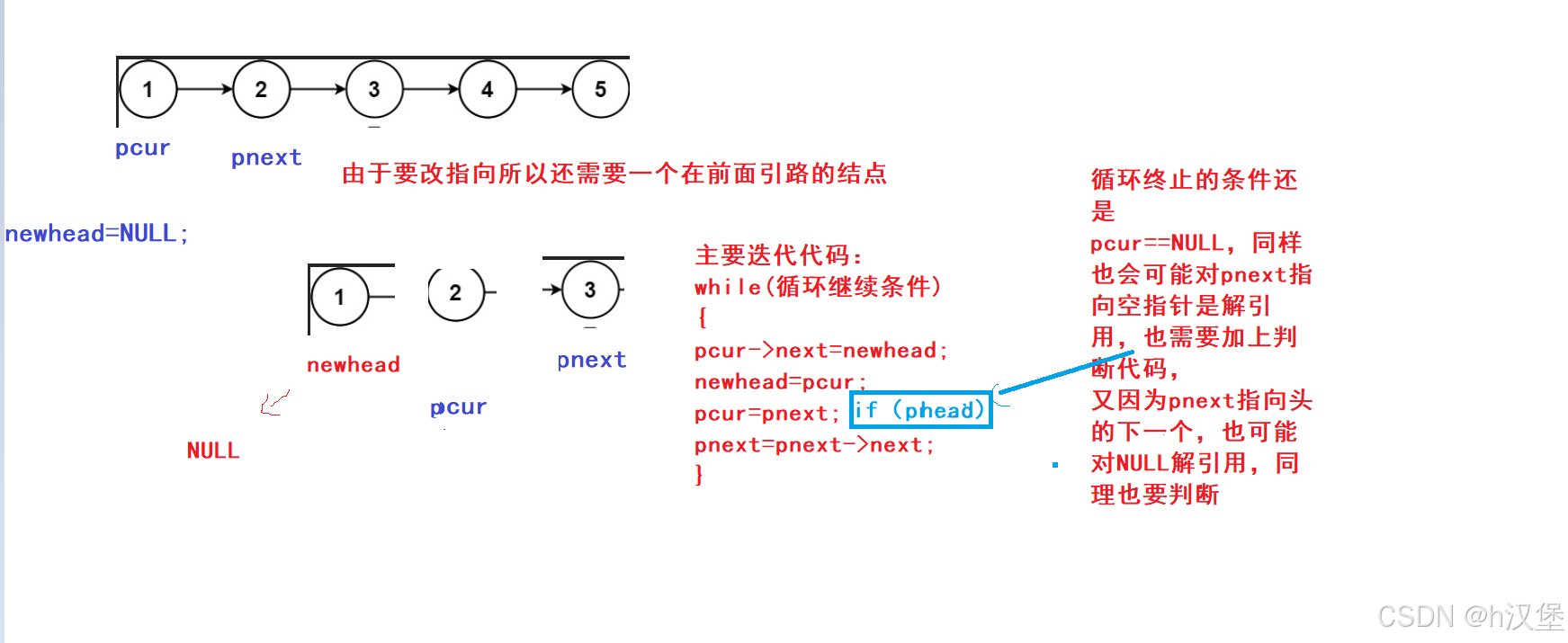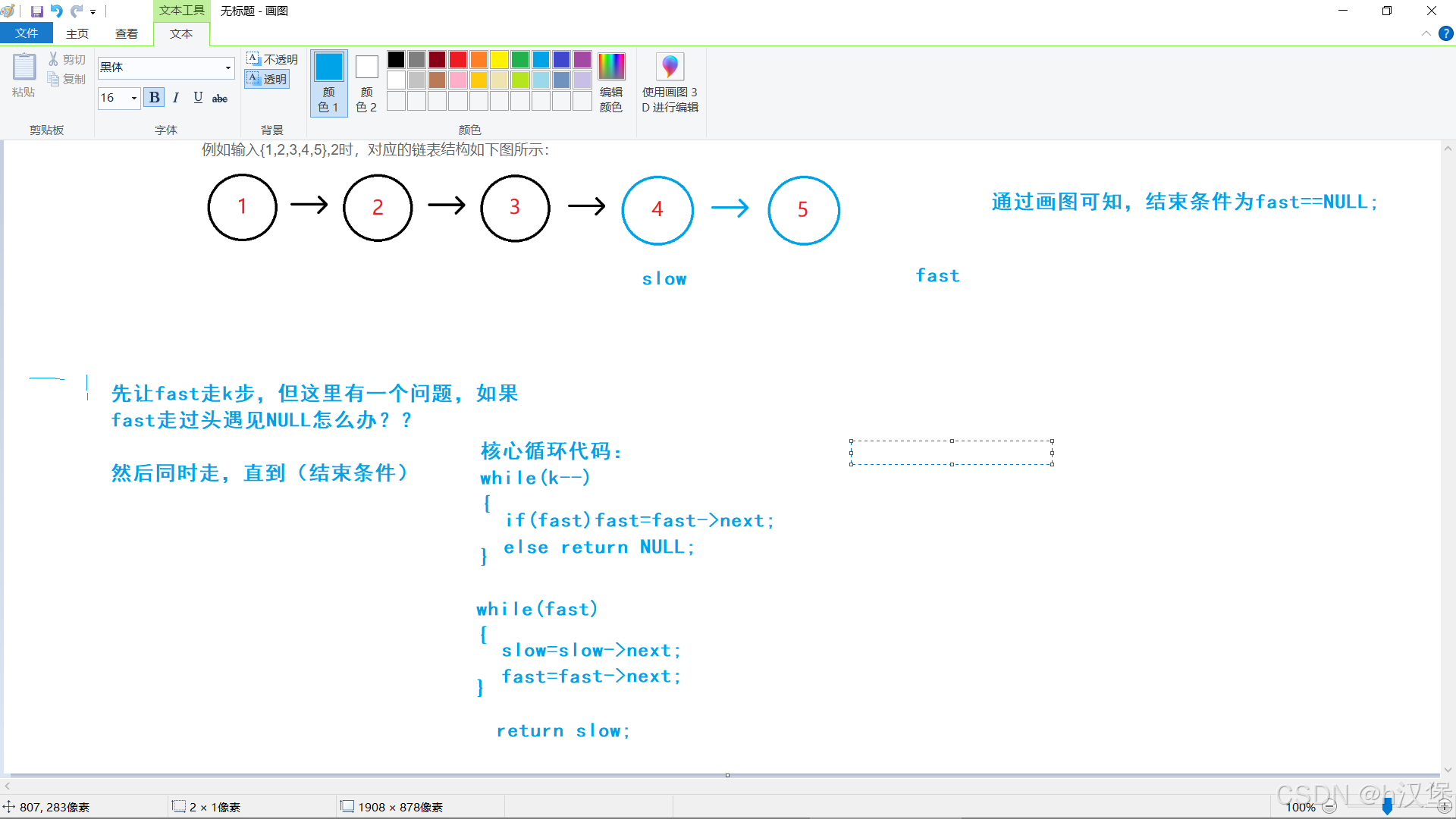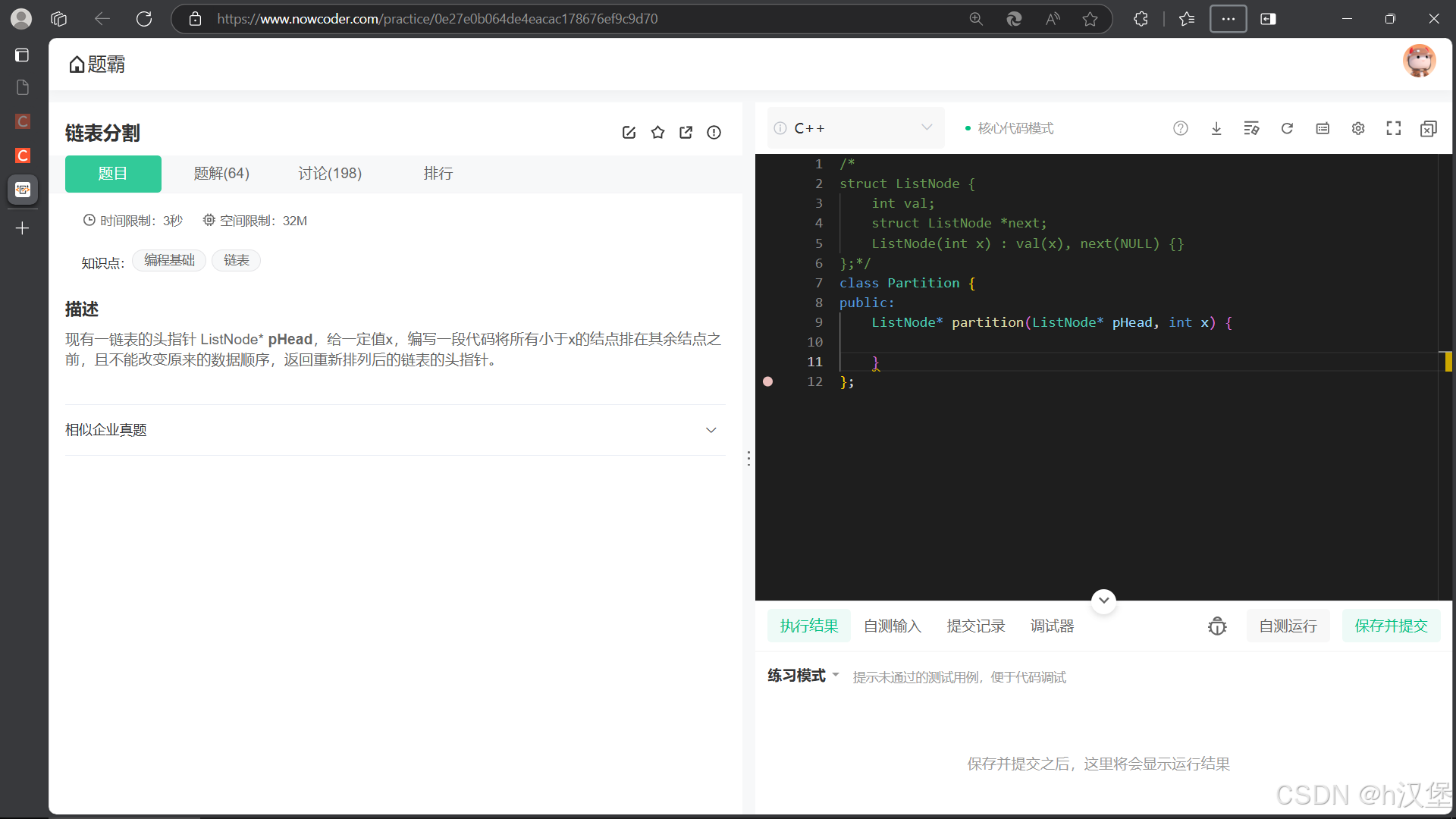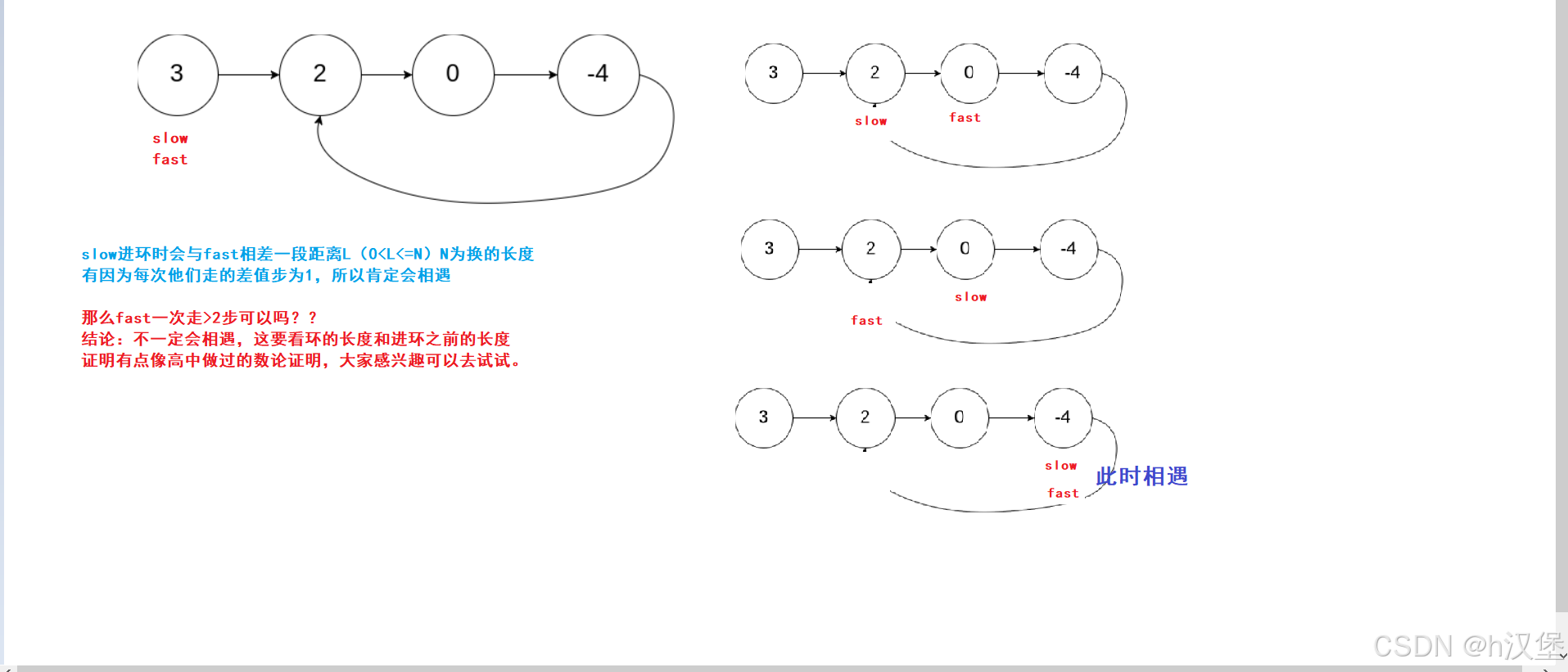一:移除链表元素

我们很容易就可以想到一个解决方案:再创建一个链表,把不是val的结点拿过来尾插。
这样确实可以但是,我们每次尾插都需要遍历一遍整个链表,这样时间复杂度就变成了O(n^2),
因此我们不妨设置一个tail尾结点来指向它的尾。
画图分析:
这里面还有一个潜在的问题就是,假如最后一个节点的数值==val怎么办,想一想。
完整代码:
/**
* Definition for singly-linked list.
* struct ListNode {
* int val;
* struct ListNode *next;
* };
*/
typedef struct ListNode ListNode;
struct ListNode* removeElements(struct ListNode* head, int val) {
ListNode* newhead;
ListNode* newtail;
ListNode* pcur = head;
newhead=newtail=NULL;
while(pcur)
{
if(pcur->val!=val)
{
if(newhead==NULL)
{
newhead=newtail=pcur;
}
else
{
newtail->next=pcur;
newtail=pcur;
}
}
pcur=pcur->next;
}
if(newtail!=NULL&&newtail->next!=NULL)
{
newtail->next=NULL;
}
return newhead;
}二:反转链表

这一题有两种解法:
解法一:
直接反转指向,比如原来二指向三,现在让三指向2.
画图分析:

经过分析我们写出了这样的代码:
struct ListNode* reverseList(struct ListNode* head) {
struct ListNode* pprev = NULL;
struct ListNode* pcur = head;
struct ListNode* pnext = head->next;
while(pcur)
{
pcur->next=pprev;
pprev=pcur;
pcur=pnext;
pnext=pnext->next;
}
return pprev;
}
放在力扣上提交

遇到错误不要慌张,我们看一下提示信息,可以发现,原来是对NULL解引用了,所以在17行那要加上判断,那么说到这了万一这个链表原来就是空呢?因此在一开始也要对这种情况处理。
完整代码:
/**
* Definition for singly-linked list.
* struct ListNode {
* int val;
* struct ListNode *next;
* };
*/
struct ListNode* reverseList(struct ListNode* head) {
struct ListNode* pprev = NULL;
struct ListNode* pcur = head;
struct ListNode* pnext;
if(head)
{
pnext = head->next;
}
while(pcur)
{
pcur->next=pprev;
pprev=pcur;
pcur=pnext;
if(pnext)
{
pnext=pnext->next;
}
}
return pprev;
}解法二:
取原链表中元素,头插到新链表的newhead中。
画图分析:
完整代码:
struct ListNode* reverseList(struct ListNode* head) {
struct ListNode* pcur = head;
struct ListNode* newhead = NULL;
struct ListNode* pnext;
if(head)
{
pnext=head->next;
}
while(pcur)
{
pcur->next = newhead;
newhead = pcur;
pcur = pnext;
if(pnext)
{
pnext = pnext->next;
}
}
return newhead;
}三:链表的倒数k个结点

我们确实可以先遍历一遍拿到链表长度,然后就可以找到倒数k个结点了。但是如果只能这么做就没有拿出来的必要了qwq。
快慢指针法:两个指针先让一个走k,然后一起走,等到k指向空(具体看下面画图分析)结束。
画图分析:
完整代码:
struct ListNode* FindKthToTail(struct ListNode* pHead, int k ) {
struct ListNode* slow;
struct ListNode* fast;
slow=fast=pHead;
while(k--)
{
if(fast)
{
fast=fast->next;
}
else {
return NULL;
}
}
while(fast)
{
slow=slow->next;
fast=fast->next;
}
return slow;
}四:链表的中间结点

这题同样也是快慢指针法,大体思路是让fast走两步,slow走一步,但是直觉告诉我们结点数的奇偶性会影响结束条件。
画图分析:

完整代码:
struct ListNode* middleNode(struct ListNode* head) {
struct ListNode* slow;
struct ListNode* fast;
fast=slow=head;
while(fast&&fast->next)
{
slow=slow->next;
fast=fast->next->next;
}
return slow;
}五:合并两个有序链表

思路:依次比较链表中的结点,然后插入小的结点
画图分析:

完整代码:
struct ListNode* mergeTwoLists(struct ListNode* list1, struct ListNode* list2) {
struct ListNode* newhead;
struct ListNode* newtail;
newhead=newtail=NULL;
struct ListNode* pcur1=list1;
struct ListNode* pcur2=list2;
if(pcur1==NULL)return pcur2;
if(pcur2==NULL)return pcur1;
while(pcur1&&pcur2)
{
if(pcur1->val<pcur2->val)
{
if(newhead==NULL)
{
newhead=newtail=pcur1;
}
else
{
newtail->next=pcur1;
newtail=pcur1;
}
pcur1=pcur1->next;
}
else
{
if(newhead==NULL)
{
newhead=newtail=pcur2;
}
else
{
newtail->next=pcur2;
newtail=pcur2;
}
pcur2=pcur2->next;
}
}
if(pcur1!=NULL)
{
newtail->next=pcur1;
}
if(pcur2!=NULL)
{
newtail->next=pcur2;
}
return newhead;
}
优化:
我们每次都要对新创建的头结点判断是否为空。
有没有一种方法可以不用判断呢?:设置一个哨兵位就可以了
struct ListNode* mergeTwoLists(struct ListNode* list1, struct ListNode* list2) {
struct ListNode* pcur1=list1;
struct ListNode* pcur2=list2;
if(pcur1==NULL)return pcur2;
if(pcur2==NULL)return pcur1;
struct ListNode* head = (struct ListNode*)malloc(sizeof(struct ListNode));
struct ListNode* tail = head;
while(pcur1&&pcur2)
{
if(pcur1->val<pcur2->val)
{
tail->next=pcur1;
tail=pcur1;
pcur1=pcur1->next;
}
else
{
tail->next=pcur2;
tail=pcur2;
pcur2=pcur2->next;
}
}
if(pcur1!=NULL)
{
tail->next=pcur1;
}
else
{
tail->next=pcur2;
}
struct ListNode* newhead=head->next;
free(head);
return newhead;
}
六:链表分割
这题没给图,直接画图分析:
画图分析:

完整代码:
class Partition {
public:
ListNode* partition(ListNode* pHead, int x) {
ListNode* lesshead =(ListNode*)malloc(sizeof(ListNode));
ListNode* lesstail=lesshead;
ListNode* greaterhead=(ListNode*)malloc(sizeof(ListNode));
ListNode* greatertail=greaterhead;
ListNode* pcur=pHead;
if(pcur==NULL)return NULL;
while(pcur)
{
if(pcur->val<x)
{
lesstail->next=pcur;
lesstail=pcur;
}
else
{
greatertail->next=pcur;
greatertail=pcur;
}
pcur=pcur->next;
}
lesstail->next=greaterhead->next;
greatertail->next=NULL;
ListNode* newhead=lesshead->next;
free(lesshead);
free(greaterhead);
return newhead;
}
};七:链表回文

首先这一题开一个900的数组也可以过,但是他并不符合空间复杂度O(1)。
然后我们说一下这一题的思路:先找中间结点,然后逆置,最后一一比较。
具体细节,请看下
画图分析:

完整代码:
/*
struct ListNode {
int val;
struct ListNode *next;
ListNode(int x) : val(x), next(NULL) {}
};*/
struct ListNode* middleNode(ListNode* A)
{
ListNode* slow = A;
ListNode* fast = A;
while(fast && fast->next)
{
fast=fast->next->next;
slow=slow->next;
}
return slow;
}
struct ListNode* reverseList(struct ListNode* head)
{
struct ListNode* pprev = NULL;
struct ListNode* pcur = head;
struct ListNode* pnext;
if(head)
{
pnext = head->next;
}
while(pcur)
{
pcur->next = pprev;
pprev = pcur;
pcur = pnext;
if(pnext)
{
pnext = pnext->next;
}
}
return pprev;
}
class PalindromeList {
public:
bool chkPalindrome(ListNode* A) {
ListNode* mid = middleNode(A);
ListNode* rhead = reverseList(mid);
ListNode* curA = A;
ListNode* curR = rhead;
while(curA && curR)
{
if(curA->val != curR->val)
{
return false;
}
else
{
curA=curA->next;
curR=curR->next;
}
}
return true;
}
};八:链表相交

思路:遍历一遍求长度(同时判断是否会相交),长的走差值步,然后一起走直到两指针相同
这一题不可以用逆置做,想一想为什么??
画图分析:

完整代码:
struct ListNode *getIntersectionNode(struct ListNode *headA, struct ListNode *headB) {
struct ListNode* curA = headA;
struct ListNode* curB = headB;
int lenA = 1;
int lenB = 1;
while(curA->next)
{
lenA++;
curA=curA->next;
}
while(curB->next)
{
lenB++;
curB=curB->next;
}
if(curA!=curB)return NULL;
int gap = abs(lenA-lenB);
struct ListNode* longlist = headA;
struct ListNode* shortlist = headB;
if(lenA < lenB)
{
longlist = headB;
shortlist = headA;
}
while(gap--)
{
longlist=longlist->next;
}
while(longlist!=shortlist)
{
longlist=longlist->next;
shortlist=shortlist->next;
}
return longlist;
}九:环形链表1

思路:快慢指针法,slow走1步fast走2步。如果相遇则带环,否则不带环
画图分析:
完整代码:
bool hasCycle(struct ListNode *head) {
struct ListNode* slow = head;
struct ListNode* fast = head;
while(fast && fast->next)
{
fast=fast->next->next;
slow=slow->next;
if(fast==slow)return true;
}
return false;
}十:环形链表2

这一题有点数学题的意思。还是先说思路:还是先slow与fast走,等到两指针相遇,在再让一个指针从都走,另一个指针从相遇位置走,直到二者再次相遇即为如环点。
画图分析:

完整代码:
struct ListNode *detectCycle(struct ListNode *head) {
struct ListNode* slow = head;
struct ListNode* fast = head;
while(fast && fast->next)
{
fast=fast->next->next;
slow=slow->next;
if(slow==fast)
{
struct ListNode* cur = head;
struct ListNode* curC = fast;
while(cur!=curC)
{
cur=cur->next;
curC=curC->next;
}
return cur;
}
}
return NULL;
}十一:复杂随机链表的拷贝
 这一次最难搞的是random指针。思路也不好想,大家还是借鉴一下大佬的思路吧。
这一次最难搞的是random指针。思路也不好想,大家还是借鉴一下大佬的思路吧。
思路:在每个节点后面插入一个一样的节点,定义cur 和 next指针 cur->next->radom=cur->radom->next,然后迭代往后。最后解开插入的结点。
画图分析:

完整代码:
struct Node* copyRandomList(struct Node* head) {
struct Node* cur = head;
//插入新节点
while(cur)
{
struct Node* newnode = (struct Node* )malloc(sizeof(struct Node));
newnode->val = cur->val;
newnode->next = cur->next;
cur->next = newnode;
cur = newnode->next;
}
//处理random
cur = head;
while(cur)
{
struct Node* newnode = cur -> next;
if(cur->random==NULL)
{
newnode->random = NULL;
}
else
{
newnode->random = cur->random->next;
}
cur = newnode->next;
}
//取新节点尾插,同时恢复原链表
cur = head;
struct Node* newhead = NULL;
struct Node* newtail = NULL;
while(cur)
{
struct Node* newnode = cur->next;
struct Node* next = newnode->next;
if(newhead==NULL)
{
newhead = newtail = cur->next;
}
else
{
newtail->next = newnode;
newtail = newnode;
}
cur->next = newnode->next;
cur = newnode->next;
}
return newhead;
}完

























 被折叠的 条评论
为什么被折叠?
被折叠的 条评论
为什么被折叠?








